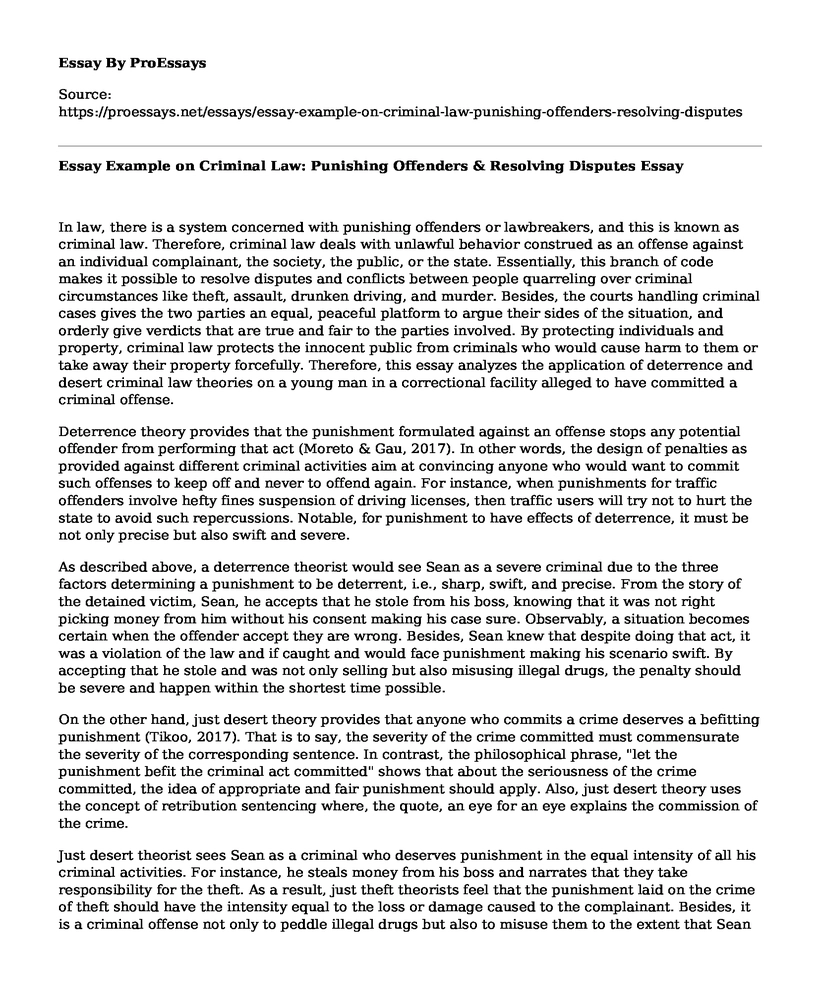In law, there is a system concerned with punishing offenders or lawbreakers, and this is known as criminal law. Therefore, criminal law deals with unlawful behavior construed as an offense against an individual complainant, the society, the public, or the state. Essentially, this branch of code makes it possible to resolve disputes and conflicts between people quarreling over criminal circumstances like theft, assault, drunken driving, and murder. Besides, the courts handling criminal cases gives the two parties an equal, peaceful platform to argue their sides of the situation, and orderly give verdicts that are true and fair to the parties involved. By protecting individuals and property, criminal law protects the innocent public from criminals who would cause harm to them or take away their property forcefully. Therefore, this essay analyzes the application of deterrence and desert criminal law theories on a young man in a correctional facility alleged to have committed a criminal offense.
Deterrence theory provides that the punishment formulated against an offense stops any potential offender from performing that act (Moreto & Gau, 2017). In other words, the design of penalties as provided against different criminal activities aim at convincing anyone who would want to commit such offenses to keep off and never to offend again. For instance, when punishments for traffic offenders involve hefty fines suspension of driving licenses, then traffic users will try not to hurt the state to avoid such repercussions. Notable, for punishment to have effects of deterrence, it must be not only precise but also swift and severe.
As described above, a deterrence theorist would see Sean as a severe criminal due to the three factors determining a punishment to be deterrent, i.e., sharp, swift, and precise. From the story of the detained victim, Sean, he accepts that he stole from his boss, knowing that it was not right picking money from him without his consent making his case sure. Observably, a situation becomes certain when the offender accept they are wrong. Besides, Sean knew that despite doing that act, it was a violation of the law and if caught and would face punishment making his scenario swift. By accepting that he stole and was not only selling but also misusing illegal drugs, the penalty should be severe and happen within the shortest time possible.
On the other hand, just desert theory provides that anyone who commits a crime deserves a befitting punishment (Tikoo, 2017). That is to say, the severity of the crime committed must commensurate the severity of the corresponding sentence. In contrast, the philosophical phrase, "let the punishment befit the criminal act committed" shows that about the seriousness of the crime committed, the idea of appropriate and fair punishment should apply. Also, just desert theory uses the concept of retribution sentencing where, the quote, an eye for an eye explains the commission of the crime.
Just desert theorist sees Sean as a criminal who deserves punishment in the equal intensity of all his criminal activities. For instance, he steals money from his boss and narrates that they take responsibility for the theft. As a result, just theft theorists feel that the punishment laid on the crime of theft should have the intensity equal to the loss or damage caused to the complainant. Besides, it is a criminal offense not only to peddle illegal drugs but also to misuse them to the extent that Sean did while trying to make ends meet for his family. For this reason, he deserves an equal punishment for the damages caused to the state, the public, and his health as provided by the just desert theory.
Conclusion
In conclusion, Sean's situation is neither ignorance nor arrogance from the societal factors, i.e., the attributes his lifestyle to the circumstances he found himself along his life journey. Besides, he narrates his ordeal to have been that of pressure from the situations he found his family in that forced him to drop out of school and start involving himself with work. Just desert theory looks at the crime from how it happened but does not cover the circumstances under which the crime took place. In contrast, deterrence theory must analyze the crime and conditions involved before determining the punishment. Therefore, it is only fair that during the period when Sean is in a correctional facility, his case should undergo a deterrence theory of criminal law to improve his chances of success upon his release.
References
Moreto, W. D., & Gau, J. M. (2017). Deterrence, legitimacy, and wildlife crime in protected areas. Conservation criminology, 45.
Tikoo, A. V. (2017). Individualization of Punishment, Just Desert, and Indian Supreme Court Decisions: Some Reflections. ILI Law Review. II. Winter (2017).
Cite this page
Essay Example on Criminal Law: Punishing Offenders & Resolving Disputes. (2023, May 29). Retrieved from https://proessays.net/essays/essay-example-on-criminal-law-punishing-offenders-resolving-disputes
If you are the original author of this essay and no longer wish to have it published on the ProEssays website, please click below to request its removal:
- Argumentative Essay Sample on Privatization of Prisons
- Just Mercy Book Review
- Poverty, Race, Mass Incarceration Essay
- Paper Example on Legislative Policy: Individual with Disability Education Act
- Intellectual Property Court Case Paper Example
- UK Charity Hit by Cyber Attack: NCA Investigates Data Theft
- Essay on War on Terror: Common Perceptions of Iraq and its Implications







